Pea weevil
Bruchus pisorum

Photo by Andrew Weeks, Cesar Australia
Summary Top
Pea weevil is a major pest of pea crops in spring. Despite its common name, it is not a true weevil and lacks the typical weevil snout. It is established in all southern Australian pea growing districts but has been particularly problematic in South Australia in recent years. After hibernating locally during summer, autumn and winter in sheltered positions, pea weevil adults fly to the nearest pea crop when spring temperatures reach about 20°C, initially infesting the crop edge, then dispersing through the crop and laying eggs on green pods. After egg hatch, larvae immediately bore into pods and feed on seeds, where they complete development before adults emerge from infested pods later in spring. Pea weevil damages crops through directly reducing seed weight and through contamination of harvested grain by live adults, causing downgrade or rejection at receival. Monitoring and spray timing is critically important. Pea weevil populations in a local area can be effectively managed where all growers practice a combination of well-timed in-crop spray treatments in spring where economic thresholds are exceeded, early harvest (before pea weevils reach maturity), fumigation of infested and/or retained seed, and good farm hygiene.
Use of sheep to graze out crop residues will remove many infested peas that remain after harvest, and reduces volunteer pea plants that allow local build-up of pea weevil in subsequent years.
Occurrence Top
Pea weevil is established in all major field pea growing areas in southern Australia, including South Australia, Western Australia, Victoria, and New South Wales. For a decade, the incidence of pea weevil has declined, but in recent years there has been a resurgence in some pea-growing areas of South Australia.
Description Top
Pea weevil is not a true weevil and lacks the typical weevil snout. Adults are chunky beetles approximately 5 mm in length, often brownish in colour flecked with white, black and grey patches. The end of the abdomen is white with two black oval spots and extends beyond the wing covers. Eggs are 1.5 mm in length, yellow and cigar shaped and are laid on young green pods in spring. Larvae are legless, curled, cream in colour, and up to 5 mm in length.
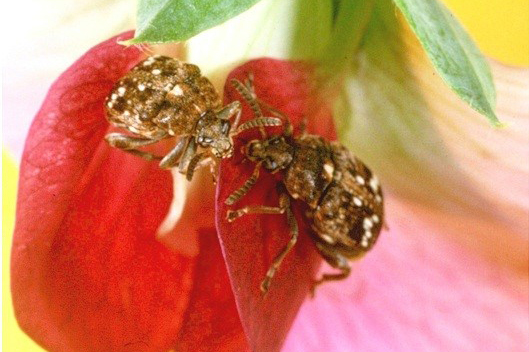
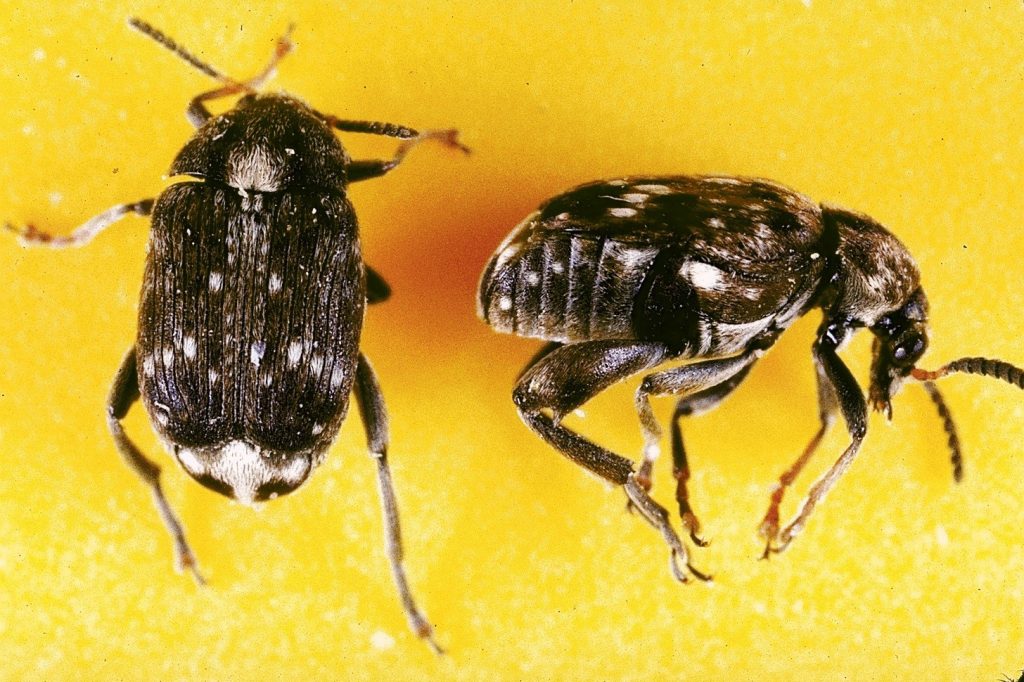
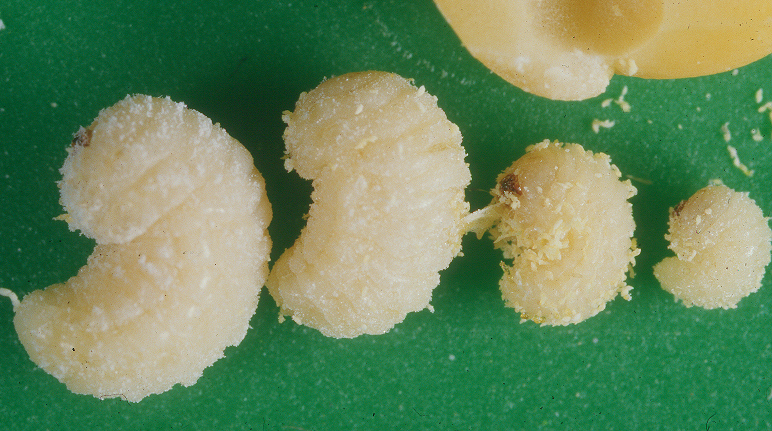
Lifecycle Top
Pea weevil adults hibernate in the local area during summer, autumn, and winter in sheltered positions, such as silos, grain bins, sheds, under the bark of trees, and in cracks in posts. They emerge in early spring when temperatures reach about 20°C and fly to the edge of the nearest pea crop to settle in the outer 10-15 m before dispersing further into the crop. Females are sexually immature when they emerge from hibernation and require a period of feeding of pea pollen for ovarian development. The first egg lay takes place 1-2.5 weeks (dependent on temperatures) after the first arrival of pea weevil in flowering crops. Larvae hatch 2-4 weeks after egg lay and bore directly into pea pods, where they feed on and in seeds and later pupate inside seeds. Larvae feed for 40-50 days and when fully grown, prepare for emergence by chewing a neat, circular 3 mm hole in the seeds before pupating. Pupation takes approximately 2 weeks, and the new generation of adult beetles emerge over several months to hibernate. Adult emergence is traditionally thought to commence in mid-to-late December, but over the past few years, earlier adult emergence has been reported in South Australia.
Pea weevils cannot reproduce in stored grain and infestations can only occur if eggs are laid into green pea pods in growing crops.

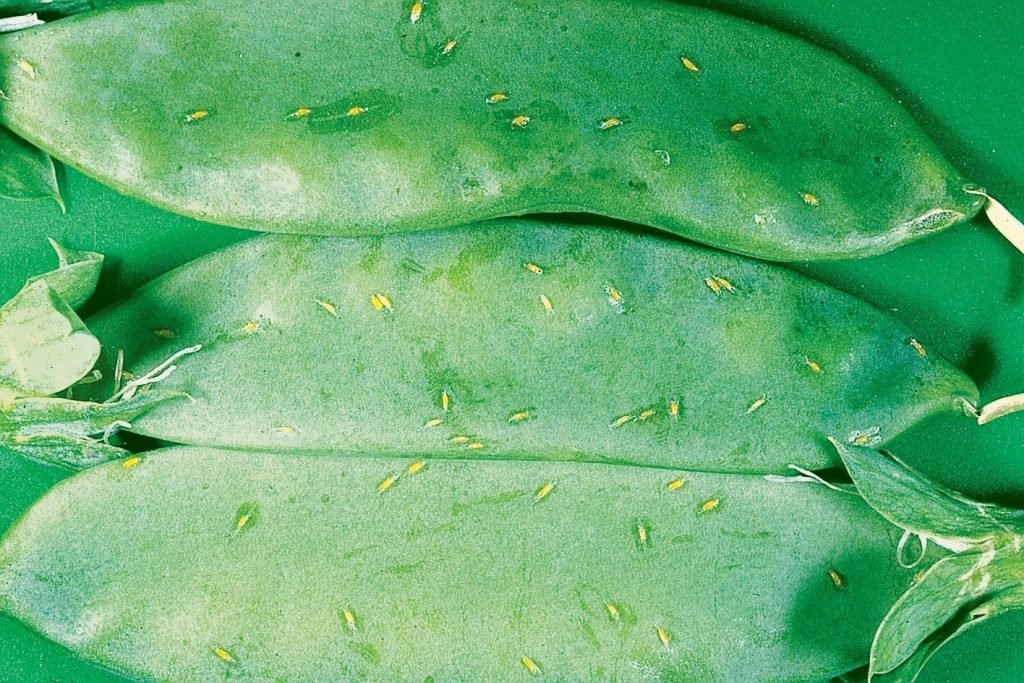
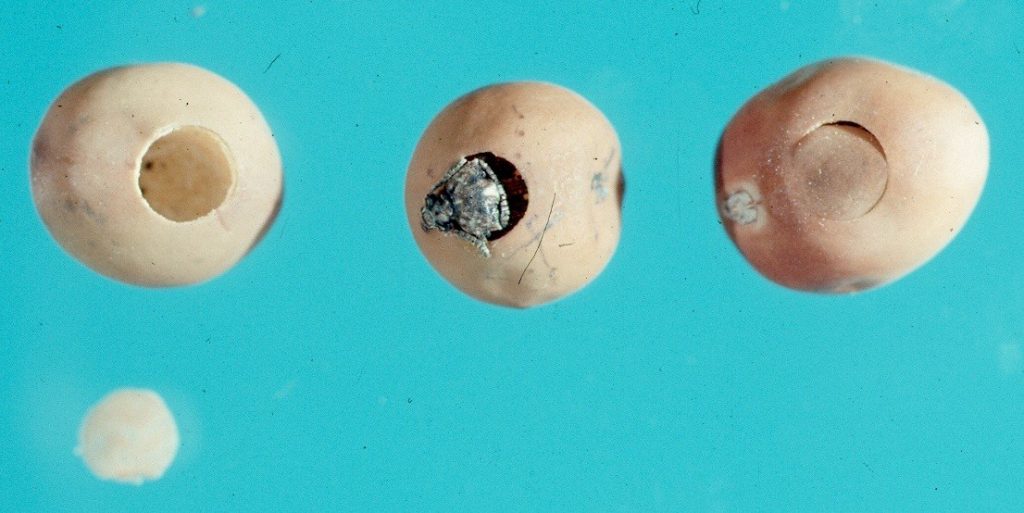
Behaviour Top
Pea weevils invade pea crops irrespective of whether the crop is flowering. They usually invade for 3-4 weeks and lay eggs for a similar time. After initially settling in crop edges, beetles disperse into the crop through a series of short flights. Larvae bore immediately into pods after hatching, where they are protected from exposure to insecticides.
Similar to Top
The pea weevil is unlikely to be confused with any other pest of peas.
Crops attacked Top
Field peas.
Damage Top
Pea weevil is a major pest of field peas. In crops with heavy infestations of pea weevil, up to 15-20% of pea seeds may be attacked by feeding larvae. Larval feeding can result in the loss of 25% of seed weight. Damaged seed is susceptible to shattering when harvested, resulting in a total yield loss of 5-10%. Weevil-infested peas threaten export markets for peas and other grains. The presence of adults (live or dead) in grain can result in downgrade or rejection at receival points. Pea weevil larvae hollow out grain and may remain in harvested grain stored on-farm or retained for seed. In recent seasons, several instances have been reported of pea weevil detection causing problems at delivery of peas, highlighting the need for proactive weevil management during spring.
Infested grain is usually rejected by the split pea trade because wastage occurs, and extra processing is necessary to remove pea weevil bodies.

Monitor Top
Monitoring pea crops for the presence of pea weevil is the key to determining whether and when to spray effectively. Monitoring is best conducted using a sweep net on calm days. Crops should be monitored every 3-4 days from the start of flowering, continuing until the crop begins to dry.
Sweep along the crop edge, beginning in areas adjacent to nearby hibernation sites such as tree-lines or sheds. Sweep in a 180° arc while walking forward. Count the number of weevils per 25 sweeps, and repeat at 5-10 sites around the crop edge. Spraying is recommended if average densities exceed 2 or more weevils per 25 sweeps.
Pea weevils invade pea crops for around 3-5 weeks. Egg laying commences within 1-2.5 weeks of the first adult invasion of flowering crops. After 2 weeks, adults may be present up to 50 m into the crop.
In seasons of high pea weevil abundance, monitoring may indicate the need for more than one spray treatment.
Economic thresholds Top
The spray threshold is at least 2 adults per 25 sweeps, averaged over 5 to 10 sampling sites.
Management options Top
Biological
No parasites, predators or diseases of pea weevil have been recorded in Australia.
Cultural
Cultural management is highly effective for pea weevil. All seed sown must be free of live adults. Any grain to be retained for seed be fumigated immediately after harvest. Ensure all purchased seed has been fumigated. Harvesting on time will minimise yield loss from pea weevil and ensure adults do not have opportunity to emerge and disperse to local hibernation sites. Remove spilled seed in paddocks and around storage sites. Baled field pea stubble can often provide ideal hibernation sites for pea weevil. Control volunteer field peas to minimise pea weevil survival.
Early harvest and delivery is recommended to prevent the new generation of adult weevils from emerging and infesting the property and surrounding district. This practice is a key factor in limiting local pea weevil populations in South Australian and Victorian pea-growing districts.
Chemical
After hatching, larvae immediately bore directly into the pea pods where they are protected from insecticide sprays. To effectively control pea weevil, insecticide sprays must be applied at the optimal time, after the majority of adults have invaded pea crops, but before they lay eggs. Most crops should be sprayed when the first flowers begin to wither and pea weevils are present. In some seasons, a repeat spray may be required where adult numbers exceed thresholds.
Early sown crops may flower before pea weevil adults invade the crops. Monitor these crops from the start of flowering and spray about 7 days from when pea weevil adults are first detected. Border sprays are effective on these crops if a minimum of 20-40 m is sprayed. Later sown crops should be sprayed as the first flowers wither and the first pods set. As pea weevil is likely to have spread throughout the crop by this time, a full-paddock treatment is recommended. Insecticides control pea weevil adults for approximately 7-10 days. Therefore, all crops should be monitored using a sweep net from 7 days post-spraying to determine the need for repeat application.
Early harvest and fumigation of the grain is recommended to kill pea weevil before the adult weevils have a chance to emerge and infest the surrounding area. Early fumigation of harvested seed helps to reduce larval damage to harvested grain and ensure that export grain is free of live insects.
Effective area wide management of pea weevil can be achieved where all growers in a district practice:
• Well-timed monitoring and spring spraying to control adults before egg laying,
• Concentrate monitoring near trees and other hibernation sites (sheds etc),
• Harvest peas as soon as sufficiently dry to pre-empt adult emergence, and avoid shattering,
• Fumigation of harvested grain that appears to be infested,
• Good farm hygiene – avoid unintentionally introducing infested seed from a supplier, cleaning up grain residues after harvest, and controlling volunteer peas.
Action calendar for pea weevil (Source: Baker, 2016)
Flowering
Early crops – Watch rural press from mid-August for advice on best spray date. Sweep-net monitor before this date to decide whether to spray.
Later crops – Sweep-net monitor during early flowering. If necessary, spray as the first flowers wither and the first pods set.
Harvest
For good pea weevil and grain quality management harvest as soon as possible, i.e. when the seed moisture level first falls to 12%.
A visual ready reckoner for harvest is when at least 39 of 40 plants randomly selected from the crop have all their pods dry and brown and their seeds hard and dry.
Post Harvest
Grain for sale – Deliver as soon as possible following harvest. Fumigate if grain is to be held for more than 1-2 weeks.
Grain for on farm storage – Fumigate as soon as possible after harvest.
Acknowledgements Top
This article was compiled by Greg Baker and Bill Kimber (SARDI).
References/Further Reading Top
Bailey PT. 2007. Pests of field crops and pastures: Identification and Control. CSIRO Publishing, Melbourne, Australia.
Baker G. 2016. Pea weevil. SARDI Entomology, South Australian Research and Development Institute, PIRSA.
http://www.pir.sa.gov.au/__data/assets/pdf_file/0004/285520/Pea_Weevil_Fact_Sheet.pdf
Henry K, Bellati J, Umina P and Wurst M. 2008. Crop Insects: the Ute Guide Southern Grain Belt Edition. Government of South Australia PIRSA and GRDC.
| Date | Version | Author(s) | Reviewed by |
|---|---|---|---|
| April 2017 | 1.0 | Greg Baker and Bill Kimber (SARDI) | Kym Perry (SARDI) and Julia Severi (cesar) |
What are PestNotes?
PestNotes are information sheets developed through a collaboration between Cesar Australia and the South Australian Research and Development Institute (SARDI). Copyright: © All material published in PestNotes is copyright protected by Cesar Australia and SARDI and may not be reproduced in any form without written permission from both agencies.
Disclaimer
The material provided in PestNotes is based on the best available information at the time of publishing. No person should act on the basis of the contents of this publication without first obtaining independent, professional advice. PestNotes may identify products by proprietary or trade names to help readers identify particular products. We do not endorse or recommend the products of any manufacturer referred to. Other products may perform as well as or better than those specifically referred to. Cesar Australia and PIRSA will not be liable for any loss, damage, cost or expense incurred or arising by reason of any person using or relying on the information in this publication. Any research with unregistered pesticides or products referred to in PestNotes does not constitute a recommendation for that particular use.

